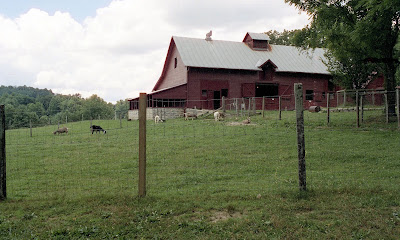A few months ago, I received a package from China with two rolls of film from Reflx Labs. I’d seen their products on Instagram, and they offered to send me a couple of rolls to try out. I hoped that I would have gotten this review done sooner, but now that I have developed the second roll, I think I can finally provide some observations on this film.
The Reflx 400Daylight is actually Eastman Vision 250D with the remjet layer removed. I commend Reflx Labs for providing this information on their website. There is only one company making ECN-2 film at this time, and it’s Eastman Kodak. While the film is being pushed 2/3 of a stop, the Eastman Vision 3 film has enough latitude to handle the modest push.
I really like the screw-top aluminum canister that the film cassette is sold in. That harkens back to the really good old days, and the aluminum canister reminds me of some 1960s Perutz film. Inside the canister is the roll of film, a keychain ring, and a DX-code sticker to replace the one on the film cassette. There is a small hole on the end of the spool to attach the keychain, which means you’ll need to ask the film lab to return the cassette if you wish to use it on the keychain. There’s nothing second-rate about this cute little package, and I loaded up the first roll in my Nikon FE. I shot that roll at the end of July, and had my local lab (Ball Photo) process the film as C-41. The results were quite good, though at the time, I thought I was seeing some “light piping” going on. There was a tiny bit at the beginning of the roll, but further camera testing revealed that I had a slight light-leak by the film door hinge. Argh!!
The second roll was loaded into my Nikon F3HP which does NOT have any light leaks. I shot that roll during my trip to Lexington, VA, and finally developed it with the new Film Photography Project ECN-2 kit. Even though the remjet has been removed, the ECN-2 chemistry and temperatures are just a bit different from C-41, and are the recommended developer. It also allowed me to compare colors with the first roll.
The only problems that I have seen with this film are the obvious light-piping early on in the roll, and after going through the images and editing, there are quite a few frames on the second roll that have black hair-like marks in the image. Dust spots and hairs will show up as white in scans, but emulsion defects will be black. It could be that these are caused by the remjet removal process, which is done prior to packaging. They are easily cloned out in editing, but I'd rather not have to do that. This wasn't seen on the first roll, so maybe it's just a random occurrence.
 |
| the arrow points to the black lines on the image |
 |
| The lowest point on the Blue Ridge Parkway - over the James River in VA |
It should be no surprise that another seller has done what Cinestill has done. In the world of ECN-2 film stocks, Cinestill figured out a way to remove the remjet coating before packaging the film, so that the film could be processed as C-41. In addition, Cinestill uprated the Vision 3 500T film to 800 ISO, about 2/3 of a stop. I typically advise shooting the ECN-2 films at the box speed, but a 2/3 stop push isn’t a big deal. The Reflx Lab 400D is similarly uprated, and the results show that the push isn’t a problem - at least in my experience. It looks good developed in C-41 as well as the native ECN-2.
Images from Roll 1
 |
| note the reddish halation from the bright spots |
 |
| ghostly sprite from the light piping |
Conclusion - overall, I like this film - Vision 250D is an excellent daylight film - which I have always shot at box speed. The Reflx Lab 400D may need some additional care by the company to avoid the light-piping along the frames and the abrasive marks that I see on roll 2. As in any secondary sale of a film, there is always the chance that your results may vary if uses or treatment are different from the manufacturer's recommendations.














No comments:
Post a Comment